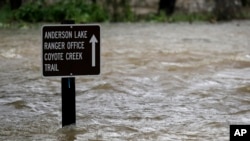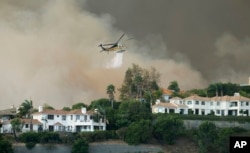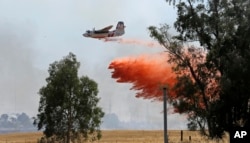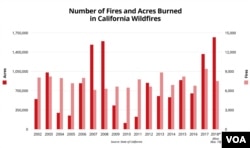Two devastating wildfires have ravaged parts of California, and the death toll Friday reached 71 with more than 1,000 missing, officials said.
Experts suggest many causes for the fires, from population growth to equipment failures to climate change. They say this year’s deadly blazes may point to worse to come.
Jennifer Balch, director of Earth Lab at the University of Colorado Boulder, said fires in the American West are intensifying.
“We’ve seen a five-fold increase in the number of large fires since the 1970s,” she said. “So, for every 20 that we saw in the 1970s, today we see 100.”
The area that is burned has also doubled, Balch said.
Extremes in snow, rain
Climate change has brought warmer temperatures and extreme variations in snow and rainfall, causing both dry and wet years, said Leroy Westerling, who studies wildfires and climate at the University of California, Merced.
He said the variations bring more fires “because in the really wet years, you’re growing more fine fuels, and in the really dry years, you’re making them very flammable.”
Fires that move quickly through tinder-dry brush can also be more deadly, Westerling said, like the fast-moving fire that destroyed most of the town of Paradise in northern California.
Westerling said California’s extended fire season now stretches into late fall, when dry conditions delay the winter rains, and gusty winds fan the fires that are still burning.
Potential causes behind wildfires
Shifting population means more chances for ignitions, with “people moving into flammable places and literally building homes in the line of fire,” Balch said.
She said humans cause 84 percent of wildfires, and lightning causes the rest.
Malfunctioning equipment and downed power lines are behind many blazes, and authorities are trying to learn if equipment failures by utility companies sparked the two large California blazes.
Careless campers are responsible for some fires, Balch said, and the most dangerous day for fires in the United States is Independence Day, the Fourth of July, when fireworks spark both structural and wildfires.
Deadly fires not forest fires
Westerling said forest management, cited by President Donald Trump as a factor in these fires, is important in reducing the intensity of some fires and maintaining the carbon balance in the atmosphere — a vital role of forests — but that the deadly fires started on private lands in the Los Angeles suburbs and the foothills of the Sierra Nevada Mountains, and not in forests.
“It is true that in some places, in some fires, that legacy of how we managed past fires can make a big difference in fire severity,” Westerling said. “But we’re seeing fires increase in size and intensity all over the map in very different types of vegetation.”
The common factor is climate change, he added.
A California report projects that, if greenhouse gas emissions and global temperatures continue to rise, by the end of the century extreme wildfires that burn more than 10,000 hectares could increase by nearly 50 percent, and the average area burned could increase by 77 percent. Westerling contributed to the report, which was released in August.
Balch added that the wildfire threat is complicated by shifts in population. She said 1.8 million homes in the Western United States are at high fire risk.
She said homeowners and communities need to be proactive in clearing flammable brush, but that the growing fire risk requires action on many fronts, from slowing climate change to reducing the risk of wildfires getting started.



